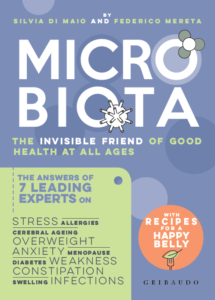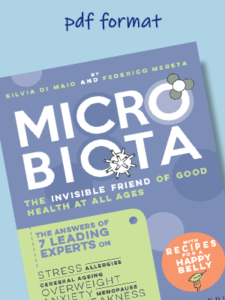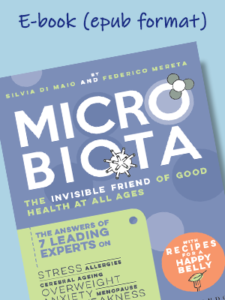Microbiota: the invisible friend of good health at all ages
The Danone Institute International presents the official translation into English of the DI Italy “ Microbiota Book “, coordinated by Silvia Di Maio and Federico Mereta, and translated by Simon Tanner.
This scientific publication is an holistic perception of the microbiota world: psychiatry, microbiology, gastroenterology, … presenting a journey inside the microbiota through a simplified language and ad hoc illustrations.
Over 500 years ago, Leonardo da Vinci admirably described the human body in his tables of unique drawings. But perhaps, in illustrating the muscles, joints and internal organs, Leonardo forgot a structure which, although lacking the anatomical dignity of the organs we all know, has now been found to be on a par with them, and performs its own precise functions. Some of these have already been discovered, others will emerge with the constant progress of science. But we should certainly not hold this oversight against that genius Leonardo, considering that not even modern manuals of anatomy depict the organ that appears increasingly important in determining our psycho-physical well-being and in regulating the functions of many parts of the body. This organ weighs more or less 800g in an adult, a little less than the heart, which we know well and which we are constantly aware of thanks to its beat, yet it does not appear in any anatomical illustration, despite being composed of a number of cells which far exceeds that of the human body.
By studying the invisible, we realize that the human body is basically nothing more than a collection of eukaryotes, bacteria and archaea. And it must be pointed out that there are around ten times more microbial cells, that is bacteria, living in our organism than eukaryotes, those that we more properly consider “ours”. However, bacteria are not distributed throughout the body: most of these prokaryotic cells are found in the human gut. Also in genetic terms, the genomes of these bacteria contain over a hundred times more genes than humans. Although we perceive bacteria as mainly being linked to disease, human life itself is dependent on the presence of “good” bacteria. As we will see, the “world” of microorganisms living inside us is both fascinating and important for our health, both physical and psychological.
This mix of historical, anthropological and scientific concepts explains why research on gut bacteria, from ancient texts to the most recent scientific evidence, is a sector of great interest for science. Thanks to a Q&A structure, 7 recognized experts explain several topics considering the different ages and conditions in life. The final part is dedicated to a weekly menu for a “healthy belly”.
The book is written and coordinated Silvia Di Maio and Federico Mereta, with the contribution of:
- Antonio Gasbarrini (Full Professor of Internal Medicine and Gastroenterology, Catholic University of the Sacred Heart. Director of the Digestive Disease Center at Policlinico Gemelli IRCCS, Rome)
- Mario Amore (Full Professor of Psychiatry, University of Genoa. Head of the Psychiatry Unit, San Martino University Hospital of Genoa)
- Giorgio Walter Canonica (Full Professor of Respiratory Diseases and Head of the Personalized Medicine Center: Asthma and Allergies, at the Humanitas Research Hospital)
- Michelangelo Giampietro (Specialist in Sports Medicine and Food Science, Sports Medicine Service, ASL Viterbo)
- Claudio Maffeis (Full Professor of Pediatrics, University of Verona. Director of the Pediatric Diabetes and Metabolic Disorders Unit, Regional Center for Pediatric Diabetes, University City Hospital of Verona)
- Lorenzo Morelli (Full Professor Department of Agricultural, Food and Environmental Sciences. Head of the Institute of Microbiology and Centre for Research into Biotechnologies, Catholic University of the Sacred Heart, Piacenza and Cremona)
- Michele Sculati (M.D., Dietitian, Specialist in Food Science and Clinical Nutrition, PhD in Public Health, Professor at the University of Pavia and Milan Bicocca-School of Medicine and Surgery)
Feel free to download the book in pdf or in epub format (adapted to e-reader):



